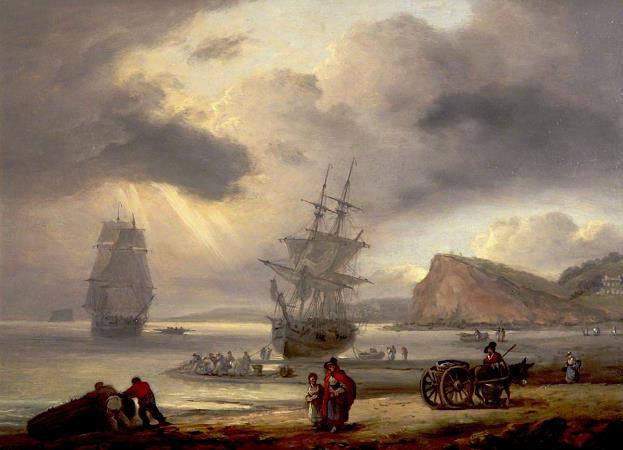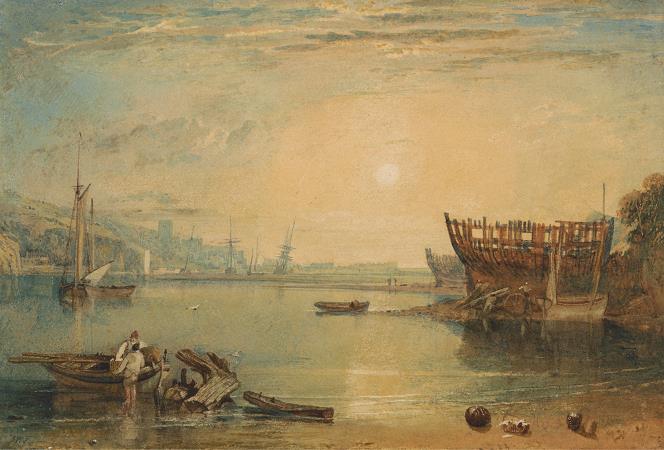Teignmouth. Teignmouth is a large seaside town, fishing port and civil parish in the English county of Devon, situated on the north bank of the estuary mouth of the River Teign about 12 miles south of Exeter. It had a population of 14,749 at the last census. In 1690, it was the last place in England to be invaded by a foreign power. From the 1800s onwards, the town rapidly grew in size from a fishing port associated with the Newfoundland cod industry to a fashionable resort of some note in Georgian times, with further expansion after the opening of the South Devon Railway in 1846. Today, its port still operates and the town remains a popular seaside holiday location. The first record of Teignmouth, Tengemuša, meaning mouth of the stream, was in 1044. Nonetheless settlements very close by are attested earlier, with the banks of the Teign estuary having been in Saxon hands since at least 682, a battle between the Ancient Britons and Saxons being recorded on Haldon in 927, and Danish raids having occurred on the Teign estuary in 1001. There were originally two villages, East and West Teignmouth, separated by a stream called the Tame, which emptied into the Teign through marshland by the current fish quay. Neither village is mentioned in the Domesday Book, but East Teignmouth was granted a market by charter in 1253 and one for West Teignmouth followed a few years later. The Tame now runs under the town in culverts and is only visible higher up the town as Brimley Brook, joined by smaller streams such as the Winterbourne. Documents indicate that Teignmouth was a significant port by the early 14th century, second in Devon only to Dartmouth. It was attacked by the French in 1340 and sent seven ships and 120 men to the expedition against Calais in 1347. Its relative importance waned during the 15th century, and it did not figure in an official record of 1577. This may have been due to silting up of the harbour caused by tin mining on Dartmoor. During the 17th century, in common with other Channel ports, Teignmouth ships suffered from raids from Dunkirkers, who were privateers from Flemish ports. It is possible that smuggling was the town's most significant trade at this time, though cod fishing in Newfoundland was also of great importance. In July 1690, after the French Admiral Anne Hilarion de Tourville defeated an Anglo-Dutch fleet at the Battle of Beachy Head, the French fleet was anchored in Torbay and some of the galley fleet travelled the short distance up the coast and attacked Teignmouth. A petition to the Lord Lieutenant from the inhabitants described the incident: on the 26th day of this instant July 1690 by Foure of the clocke in the morning, your poor petitioners were invaded to the number of 1,000 or thereabouts, who in the space of three hours tyme, burnt down to the ground the dwelling houses of 240 persons of our parish and upwards, plundered and carried away all our goods, defaced our churches, burnt ten of our ships in the harbour, besides fishing boats, netts and other fishing craft. After examining 'creditable persons' the Justices of the Peace concluded that: by the late horrid invasion there were within the space of 12 houres burnt downe and consumed 116 dwelling houses. and also 172 dwelling houses were rifled and plundered and two parish churches much ruined, plundred and defaced, besides the burning of ten saile of shipps with the furniture thereof, and the goods and merchandise therein. As a result, the Crown issued a church brief that authorised the collection of E11,000 for the aid of the town. Churches from as far afield as Yorkshire contributed, and the collections enabled the further development of the port. This was the last invasion of England, and French Street with its museum is named in memory of the occasion. In the 1600s and 1700s there are records of a windmill on the Den-an area that was then a large sand dune, and is now a grassy public open space near the seafront. By 1759 this windmill was demolished.
more...



